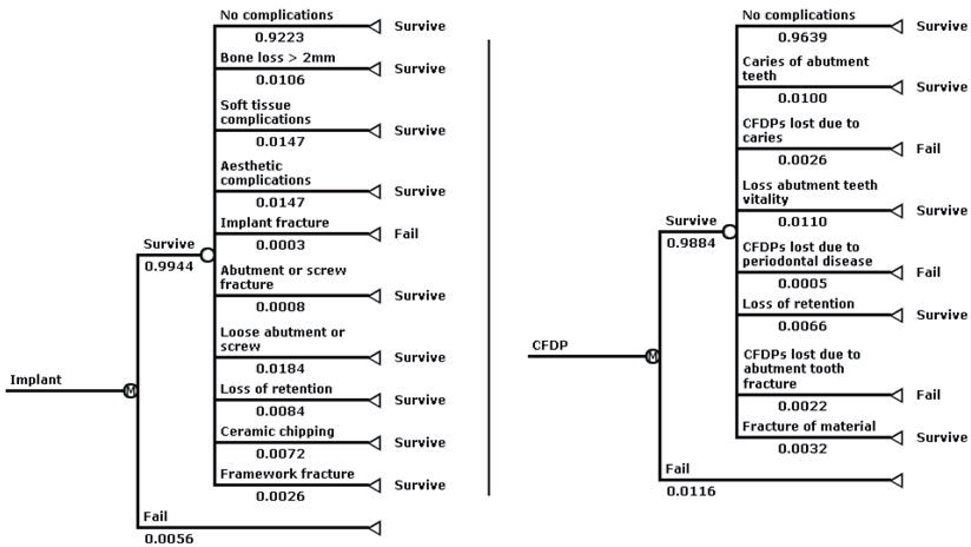J Adv Prosthodont.
2016 Feb;8(1):53-61. 10.4047/jap.2016.8.1.53.
The analysis of cost-effectiveness of implant and conventional fixed dental prosthesis
- Affiliations
-
- 1School of Dentistry, Chonnam National University, Gwangju, Korea.
- 2Northwestern University, USA.
- 3Department of Prosthodontics, School of Dentistry, Dental Science Research Institute, Chonnam National University, Gwangju, Korea.
- 4Department of Orthodontics, School of Dentistry, Dental Science Research Institute, Chonnam National University, Gwangju, Korea. hjlim@jnu.ac.kr
- KMID: 2393196
- DOI: http://doi.org/10.4047/jap.2016.8.1.53
Abstract
- PURPOSE
This study conducted an analysis of cost-effectiveness of the implant and conventional fixed dental prosthesis (CFDP) from a single treatment perspective.
MATERIALS AND METHODS
The Markov model for cost-effectiveness analysis of the implant and CFDP was carried out over maximum 50 years. The probabilistic sensitivity analysis was performed by the 10,000 Monte-Carlo simulations, and cost-effectiveness acceptability curves (CEAC) were also presented. The results from meta-analysis studies were used to determine the survival rates and complication rates of the implant and CFDP. Data regarding the cost of each treatment method were collected from University Dental Hospital and Statistics Korea for 2013. Using the results of the patient satisfaction survey study, quality-adjusted prosthesis year (QAPY) of the implant and CFDP strategy was evaluated with annual discount rate.
RESULTS
When only the direct cost was considered, implants were more cost-effective when the willingness to pay (WTP) was more than 10,000 won at 10th year after the treatment, and more cost-effective regardless of the WTP from 20th year after the prosthodontic treatment. When the indirect cost was added to the direct cost, implants were more cost-effective only when the WTP was more than 75,000 won at the 10th year after the prosthodontic treatment, more than 35,000 won at the 20th year after prosthodontic treatment.
CONCLUSION
The CFDP was more cost-effective unless the WTP was more than 75,000 won at the 10th year after prosthodontic treatment. But the cost-effectivenss tendency changed from CFDP to implant as time passed.
Keyword
MeSH Terms
Figure
Reference
-
1. Hebel K, Gajjar R, Hofstede T. Single-tooth replacement: bridge vs. implant-supported restoration. J Can Dent Assoc. 2000; 66:435–438.2. Garcia LT, Cronin RJ Jr. The partially edentulous patient: fixed prosthodontics or implant treatment options. Tex Dent J. 2003; 120:1148–1156.3. Pennington MW, Vernazza CR, Shackley P, Armstrong NT, Whitworth JM, Steele JG. Evaluation of the cost-effectiveness of root canal treatment using conventional approaches versus replacement with an implant. Int Endod J. 2009; 42:874–883.4. Kim SG, Solomon C. Cost-effectiveness of endodontic molar retreatment compared with fixed partial dentures and single-tooth implant alternatives. J Endod. 2011; 37:321–325.5. Bouchard P, Renouard F, Bourgeois D, Fromentin O, Jeanneret MH, Beresniak A. Cost-effectiveness modeling of dental implant vs. bridge. Clin Oral Implants Res. 2009; 20:583–587.6. Cicciù M, Beretta M, Risitano G, Maiorana C. Cemented-retained vs screw-retained implant restorations: an investigation on 1939 dental implants. Minerva Stomatol. 2008; 57:167–179.7. Cicciù M, Bramanti E, Matacena G, Guglielmino E, Risitano G. FEM evaluation of cemented-retained versus screw-retained dental implant single-tooth crown prosthesis. Int J Clin Exp Med. 2014; 7:817–825.8. Jacobson JJ, Maxson BB, Mays K, Kowalski CJ. A utility analysis of dental implants. Int J Oral Maxillofac Implants. 1992; 7:381–388.9. Sonnenberg FA, Beck JR. Markov models in medical decision making: a practical guide. Med Decis Making. 1993; 13:322–338.10. Jung RE, Zembic A, Pjetursson BE, Zwahlen M, Thoma DS. Systematic review of the survival rate and the incidence of biological, technical, and aesthetic complications of single crowns on implants reported in longitudinal studies with a mean follow-up of 5 years. Clin Oral Implants Res. 2012; 23:2–21.11. Pjetursson BE, Tan K, Lang NP, Brägger U, Egger M, Zwahlen M. A systematic review of the survival and complication rates of fixed partial dentures (FPDs) after an observation period of at least 5 years. Clin Oral Implants Res. 2004; 15:667–676.12. Peter M. . Cost-Effectiveness Analysis in Health: A Practical Approach. 2nd ed. San Francisco: John Wiley & Sons.;2008.13. Al-Quran FA, Al-Ghalayini RF, Al-Zu'bi BN. Single-tooth replacement: factors affecting different prosthetic treatment modalities. BMC Oral Health. 2011; 11:34.14. Meyenberg KH, Imoberdorf MJ. The aesthetic challenges of single tooth replacement: a comparison of treatment alternatives. Pract Periodontics Aesthet Dent. 1997; 9:727–735.15. Gold MR, Siegel JE, Russell LB, Weinstein MC. Cost-effectiveness in health and medicine. New York: Oxford University Press;1996. p. 91–92.16. Andrea S, Stefano T, Francesca C, Marco R. Sensitivity analysis in practice: a guide to assessing scientific models. Chichester: John Wiley & Sons.;2004.
- Full Text Links
- Actions
-
Cited
- CITED
-
- Close
- Share
- Similar articles
-
- Implant-Supported Fixed Dental Prostheses with New Retention Type Using Zirconia Ball and Nickel-Titanium Spring
- Clinical cases of implant-supported fixed dental prosthesis using modified lingual screw system (T-screw system)
- Occlusion for implant-supported fixed dental prostheses in partially edentulous patients: a literature review and current concepts
- Full mouth rehabilitation of edentulous patient with fixed implant prosthesis
- Restoration of Mandibular Edentulous Patient By Dental Implant




